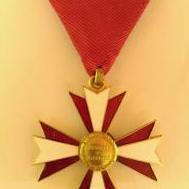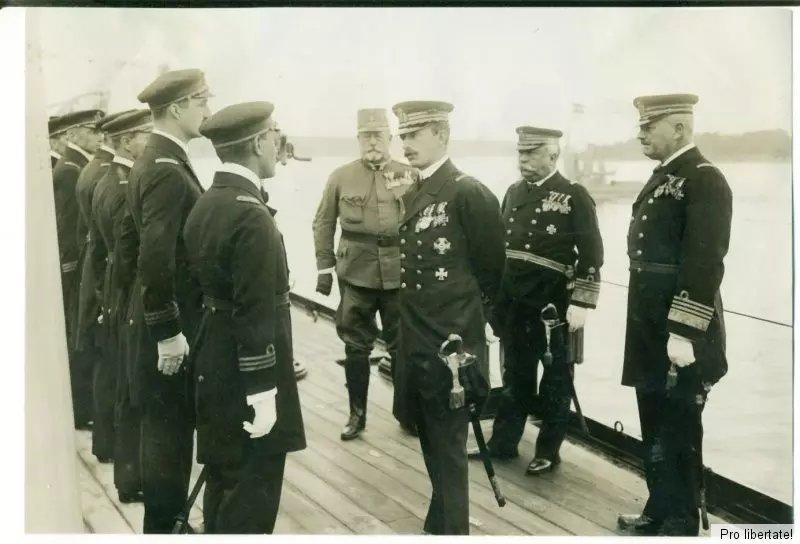-
Posts
200 -
Joined
-
Last visited
-
Days Won
5
Content Type
Profiles
Forums
Blogs
Gallery
Events
Store
Posts posted by Christian1962
-
-
It could awarded just once.
And it´s not true that it could not be awarded to Jews - that´s pure nonsense.
Emil Sommer, later chairman of the Jewish Front Fighters Union earned it in 1918. Just as example.
Regards
Christian
2 -
Gentlemen,
I can just provide some points:
1. The number of more than 400 FML is out of any doubt in my opinion. There is a good overview in Jörg Steiner´s book "Schematismus der Generale und Obersten der k.u.k. Armee 31.12.1918": https://library.hungaricana.hu/en/view/Andere_Steiner_1992/?pg=0&layout=s
2. I am sure there were many FML without EKII. German decorations in general were bestowed just to officers who served in functions and commands connected to german troops or under german command. There were many FML who never had this connection. Don´t forget that many of them were on duty in homeland functions, esp. called back to duty generals.
3. EKII was often given out like a tinnie. There were many doctors and even military officials who received it.
4. EKI was not as rare with lower-ranking officers. There were captains and majors who received it. I can give some examples: Ernst Pauer von Arlau, Edmund Glaise-Horstenau, Alfred Jansa, Rudolf Zu der Luth, Franz Böhme, Friedrich Moro.
5. Indeed it´s a problem that foreign decorations are just listed in the "Personalverordnungsblatt für die k.u.k. Armee" and not in "Rangliste". So you can just find them if you go through ten thousends of pages between 1914 and 1918.
Just my two cents.
I hope Glenn can provide some more facts.
Regards
Christian
0 -
2 minutes ago, Von Thronstahl said:
This is more than I expected. Thank you very much for your help Christian1962 .
You are welcomed!
Regards
Christian
0 -
The text is: "S(einem)/l(ieben) Toni Kolbesen zur fr(eun)dl(ichen) Erinnerung. 1913. Rebhahn Oberstlt."
Obstlt Rebhahn and Oberleutnant-Rechnungsführer Anton Kolbesen served together with Armeeschießschule in 1913.
Rebhahn was former officer of IR 92, which had white as "Regimentsfarbe". All fits.
I could find Rebhahn last time in Schematismus 1914. He received knight´s cross of Franz Joseph-Orden in 1913 or 1914.
Rebhahn received Orden der Eisernen Krone 3. Kl. mit der Kriegsdekoration on 22.11.1914 serving with k.k. Landsturm-Infanterieregiment Nr. 12.
He lost his life in the field on 2nd of August 1915 with rank of colonel as acting commander of IR 77 north-west of Lublin.
On 27.10.1915 he was posthumus awarded "Ritterkreuz des Leopoldordens mit der Kriegsdekoration".
Regards
Christian
2 -
You are welcomed!
Regards
Christian
0 -
I am not sure about the "b", the rest should mean "Im Auftrag des b.... Regimentskommandeurs".
b.: evt. "beurlaubten"?
Regards
Christian
0 -
"Im Auftrag des b(ayerischen) Roten Kreuzes"???
It would be helpful to know the context...
Regards
Christian
0 -
0
-
"Meinem lieben guten Papa einen dankbaren Gruß von sein lieben treuen Sohn Emil" - Emil not confirmed.
1 -
I could imagine it´s a private purchase officer´s bayonet. The knot is a 1917/18 officer´s knot with a cypher "K" for "Karl I.".
Regards
Christian
0 -
8 hours ago, laurentius said:
James Austin Domage does not sound very Italian, are there no other decorations or miniatures? With such a name I would be inclined to think that he is English or American. All awards seem to have been bestowed during the reign of Victor Emmanuel II.
Kind regards, Laurentius
Dolmage was a british officer as we can read.
Regards
Christian
0 -
The highest WO rank is "Chefinspektor".
For further information: https://www.bmi.gv.at/Downloads/files/UniformUnterscheidungszeichenBundespolizei2016.pdf
Regards
Christian
0 -
It´s an "Bezirksinspektor" of the Austrian federal police after 1945. This insignia were in use until the end of the 1990ties.
A kind of NCO rank.
Regards
Christian
0 -
Looks like a "Windhundkopf"-Punze for silver.
Regards
Christian
1 -
I could just give a time frame for the pic:
EH Karl was promoted to Generaloberst effective with 01.11.1916. Here he is still General der Kavallerie.
On 26.05.1916 he got the allowance to wear the prussian Pour le merité.
This should narrow down the time frame for the pic to May - October 1916. Krafft was under EH Karl´s command from September/October 1916. I would assume the pic was taken then.
Sorry no hint for the town.
Regards
Christian
0 -
I was referring to the last order of precedence which was given out by the "liquidierendes k.u.k. Kriegsministerium" in 1918/19. You will find it in Michetschläger "Das Ordensbuch der gewesenen österreich-ungarischen Monarchie".
I tryed to make a pic but it is not of best quality, sorry for that.
It´s quite interesting because they were featuring a new Kriegserinnerungsmedaille 1914 - 1918 and a Kriegserinnungskreuz.
Regards
Christian
0 -
Just a supplement referring to the Mosaner-group:
the problem is that the bar is a mix between K.u.k. and republic.
The k.u.k. precedence would have been:
EKO.3.X, BMVM.X, KTK, VerwM, Kriegsmedaille, JM1898, JK1908
then were added: Weltkriegserinnerungsmedaille 1914 - 18 and Tiroler Landesdenkmünze 1914 - 18.
The precedence for Bundesheer would have been:
EKO.3.X, BMVM.X, KTK, VerwM, Kriegsmedaille (this is questionable but most probably), Weltkriegserinnerungsmedaille 1914 - 18, JM1898 and JK1908. For officers and NCOs serving in Bundesheer it was not allowed to wear Tiroler Landesdenkmünze because it was not an official accepted decoration by the republic (as always in Austria they did it at all against the rules). But civilians and vets could wear it. And Morsaner was a vet and not in active service.
Bulgarian war medal would have been always on last position.
It is remarkable that the Hindenburg-cross ist just on the ribbon bar but not the medal bar. And look at the inverted swords for the Weltkriegserinnerungsmedaille what is very strange.
Regards
Christian
0 -
Thank you for confirming my opinion. It is evident that the owner/maker of this bar used an old style cross to substitute a 25-years-cross from the 1934 - 1938 period because they were - not congruent but - very similar with their doubled-headed eagle. Or they took even what was on stock - however.
The bar doesn´t appear to be a fake anyway. Therefore it´s the best conclusion.
Regard
Christian
0 -
I see what you mean. I would assume that the service cross should be a 1934 - 1938 type and not a 1849 - 1918 one. The ribbon is a 1934 - 1938 ribbon and they would have used the 1849 - 1918 type as a taylors copy.
An officer awarded the 25 years cross in 1918 would have served from 1893 on and therefore would have been born minimum in 1872/73. Such officers had to retire with age of 50 in 1922/23 and would not have been in active service in 1938 at an age of 65/66 years.
If it would have been a veterans bar (then for a senior officer) there would have been higher grade decorations on it, like an Iron crown III. class f.e.
The "Ostmark"-medal is a distinctive hint that the officer was member of the NSR (Nationalsozialistischer Soldatenring). This makes it more probably that he was in active service in 1938.
With 40 years experience as collector and 30 years as military historican I would tend to see my first thesis as more likely.
But as always with austrian officers: all is possible...
Regards
Christian
0 -
The medal is a golden one. It is possible that during WW1 old medals which were still on stock or in museums were used for decorating actual services instead of melting them and produce new ones. It is possible that our Fähnrich wore a medal which was from an ancestor exchanging it with his own.
Jörg Steiner writes in his "Heldenwerk" (pg. 9) that from August 1914 until March 1915 medals of all types left on stock were used because of the high amount needed.
The only issue which is sure is that he did not take part in a war before 1914.
Regards
Christian
0 -
3 hours ago, CRBeery said:
Wow! Many thanks for that. Is this from a Rank List? It makes the bar very special to me when it has a name.
Thanks to all!
It´s partially from a Rank list of 1937 and other sources (Ostmark-Medal).
Referring to the 2nd bar: it would be helpful to see a detailed pic of the inscription on the backside of MVK III.
Be careful: he hast NO 25-years-service cross but the "Mobilisierungs-Erinnerungskreuz 1912/13". We can assume that he was not commissioned yet in 1908, so he did not receive the 25-years-cross before March 1938. Otherwise it is possible that he did not wear it on his bar. Not all officers did so.
But we can be pretty sure that he became POW in 1914/15 (Przemysl?) and came back in 1918 or later. Otherwise he would have received more medals during WW1.
Regards
Christian
0 -
Good morning,
maybe I can give your bar a name. Just checking the list of Austrian officers in active service in March 1938 there would be just one candidate with exactly this combination of medals:
Niedermayer Karl (28.01.1890 – 06.08.1965), Oberstleutnant and commander of TelBaon 7 (signals batt.),
serving in the Wehrmacht with the staff of "Kommandeur der Nachrichtentruppen XVIII" in 1939.
I can´t check if he was doing duty in "Präsidialbüro des Kriegsministeriums" in 1916. Maybe there was another guy who was not longer in active service in 1938.
The mark "A" means the medal is made of silver.
Regards
Christian
0 -
there are some in today´s auction at www.dorotheum.com "Orden und Auszeichnungen".
Regards
Christian
0 -
1 hour ago, 1812 Overture said:
It is not EH Friedrich but Generaladjutant Prinz Zdenko Lobkowitz.
Regards
Christian
0





.jpg.272f5a43624f6ee9f3f63b1c853a4981.jpg)

.jpg.84a04ab93a5223ed574bfb8a6b873d06.jpg)
Question: How many Karl Truppen Crosses can a recipient earn?
in Austro-Hungarian Empire
Posted
Here are the statues for the Karl-Truppen-Kreuz. I wouldn´t find any passage which would exclude the award for jews:
https://alex.onb.ac.at/cgi-content/alex?aid=stv&datum=1916&page=6549&size=27
As we all know Austria-Hungary was a multi-national and multicultural empire. There was no reason to exclude jews from distinct decorations - just with one exception: the Order of the Fleece which was a House Order of the Habsburg Dynasty.
Kindest regards
Christian